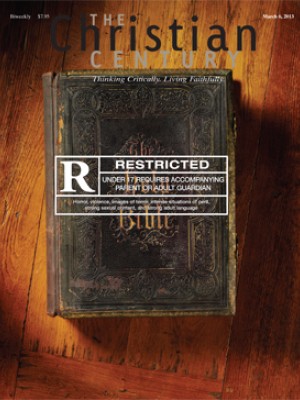More than entertainment

The shootings in Newtown are old news, but their effects are still on my mind and heart. They’ve affected the way I see movies. Before Newtown, I probably would have gone to see Tom Cruise in Jack Reacher without hesitating. But now I cringe at the idea, knowing that the film begins with a sniper surveying his targets among civilians. I feel similarly about Quentin Tarantino’s Django Unchained, knowing that it contains stretches of prolific gun violence, a whipping, and the fighting of slaves to the death.
I worry, too, about other films that I would never see but that have reportedly been met with glee by the audiences that have flocked to see them. The lead example here is Texas Chainsaw 3D, which opened little more than a month after the Newtown events. It scored $23 million on its opening weekend. As the antihero Leatherface chops off the hands and feet of his victims, viewers with 3-D glasses see (virtually) globs of blood fly from the screen. One film critic reported that during these scenes the theater audience shrieked and sometimes clapped.
Read our latest issue or browse back issues.
One favorite defense of cinematic violence among filmmakers is to draw a line between film entertainment and real-world violence. Arnold Schwarzenegger, for example, recently argued that fictional violence and Newtown must be kept “separate.” He elaborated, “This is entertainment, and the other is a tragedy beyond belief and serious and the real deal.”
Similarly, Tarantino was nettled by a journalist who wondered about a connection between movie violence and actual violence. “Don’t ask me a question like that,” he shot back. “I’m not biting. I refuse your question. . . . I’m shutting your butt down.”
One problem with the “it’s just entertainment” argument is that it radically (if unintentionally) devalues the work filmmakers do. It says that films don’t really matter, that they can’t affect the way we see and interpret and experience our world. In other words, it denies that films are—or can be—art.
Of course, the relation of art to the real world is complicated and complex. Consuming good art doesn’t automatically or necessarily make one a better person. The premier, if hackneyed, example here is that of the Nazis who enjoyed listening to Schubert while operating the concentration camps. They could listen to great music at one moment and in the next commit the most horrible of atrocities.
But if the relationship between art and the real world is complex, that doesn’t mean there is no relationship. The liberal arts are built on the hope that exposure to art can deepen people’s sensitivities and expand their horizons. And culture (popular as well as “high”) matters. Culture shapes and forms persons. Culture includes what we do in our work—and what we do with our guns. It also includes what we do at play or at leisure—listening to music, reading books, watching films—which is also part of the real world.
Christians can’t buy the “it’s just entertainment” argument. For Christians, all of creation is God’s creation. That includes art as well as the tragedies of the “real world.” Hence the Bible includes poetry as well as history. Worship is about how we play as well as how we work. And Christian discipleship is about forming whole persons, not persons fractured between “entertainment” and the “real world.”
Accordingly, the early church reacted against the obsessions with violence in the surrounding culture. Famously, Augustine and others protested the “entertainment” of the gladiatorial games. Their arguments included opposition to the “bloodlust” they believed was cultivated by the games.
Schwarzenegger and Tarantino might point out that the gladiatorial games involved actual violence, whereas movies depict but do not enact actual violence. That is certainly true. Yet Augustine and others were not only protesting the violence. They worried about the coarsening of culture and the effects on those who regarded the violence as entertaining.
We may fairly wonder at least if hyperviolent films are contributing to the coarsening of our own culture. It seems we need ever greater quantities of gore to achieve the shocks and thrills some films intend to elicit. Not so many years ago, Texas Chainsaw 3D would have been rated NC-17. Now it earns an R rating and plays to teenagers. The evolution—or devolution—of the ratings system is one gauge of the coarsening not only of movies but of the moviegoing culture.







